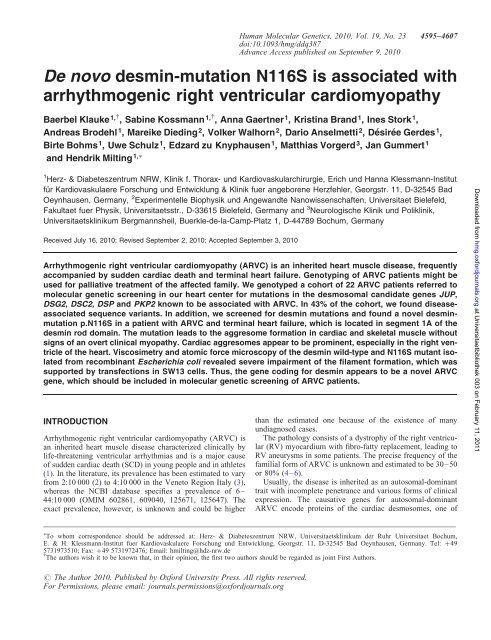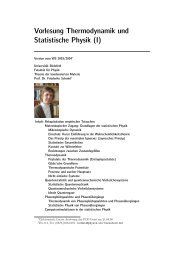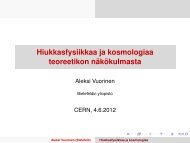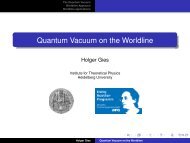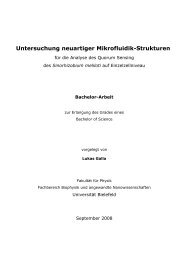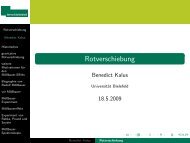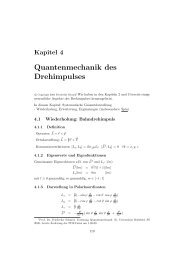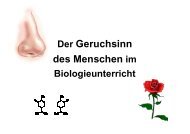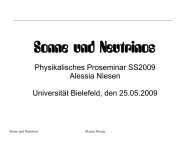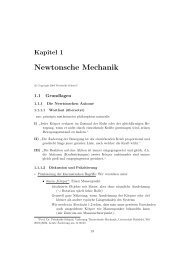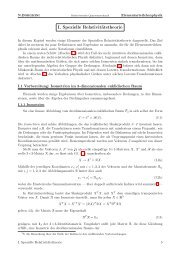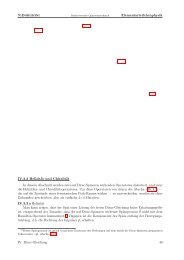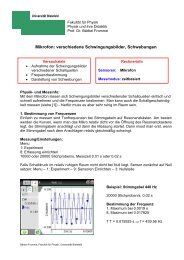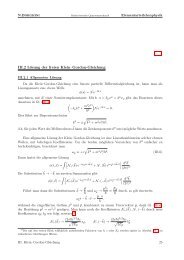De novo desmin-mutation N116S is associated with ... - ResearchGate
De novo desmin-mutation N116S is associated with ... - ResearchGate
De novo desmin-mutation N116S is associated with ... - ResearchGate
You also want an ePaper? Increase the reach of your titles
YUMPU automatically turns print PDFs into web optimized ePapers that Google loves.
<strong>De</strong> <strong>novo</strong> <strong>desmin</strong>-<strong>mutation</strong> <strong>N116S</strong> <strong>is</strong> <strong>associated</strong> <strong>with</strong><br />
arrhythmogenic right ventricular cardiomyopathy<br />
Baerbel Klauke 1,{ , Sabine Kossmann 1,{ , Anna Gaertner 1 , Kr<strong>is</strong>tina Brand 1 , Ines Stork 1 ,<br />
Andreas Brodehl 1 , Mareike Dieding 2 , Volker Walhorn 2 , Dario Anselmetti 2 ,Désirée Gerdes 1 ,<br />
Birte Bohms 1 , Uwe Schulz 1 , Edzard zu Knyphausen 1 , Matthias Vorgerd 3 , Jan Gummert 1<br />
and Hendrik Milting 1,∗<br />
1 Herz- & Diabeteszentrum NRW, Klinik f. Thorax- und Kardiovaskularchirurgie, Erich und Hanna Klessmann-Institut<br />
für Kardiovaskulaere Forschung und Entwicklung & Klinik fuer angeborene Herzfehler, Georgstr. 11, D-32545 Bad<br />
Oeynhausen, Germany, 2 Experimentelle Biophysik und Angewandte Nanow<strong>is</strong>senschaften, Universitaet Bielefeld,<br />
Fakultaet fuer Physik, Universitaetsstr., D-33615 Bielefeld, Germany and 3 Neurolog<strong>is</strong>che Klinik und Poliklinik,<br />
Universitaetsklinikum Bergmannsheil, Buerkle-de-la-Camp-Platz 1, D-44789 Bochum, Germany<br />
Received July 16, 2010; Rev<strong>is</strong>ed September 2, 2010; Accepted September 3, 2010<br />
Arrhythmogenic right ventricular cardiomyopathy (ARVC) <strong>is</strong> an inherited heart muscle d<strong>is</strong>ease, frequently<br />
accompanied by sudden cardiac death and terminal heart failure. Genotyping of ARVC patients might be<br />
used for palliative treatment of the affected family. We genotyped a cohort of 22 ARVC patients referred to<br />
molecular genetic screening in our heart center for <strong>mutation</strong>s in the desmosomal candidate genes JUP,<br />
DSG2, DSC2, DSP and PKP2 known to be <strong>associated</strong> <strong>with</strong> ARVC. In 43% of the cohort, we found d<strong>is</strong>ease<strong>associated</strong><br />
sequence variants. In addition, we screened for <strong>desmin</strong> <strong>mutation</strong>s and found a novel <strong>desmin</strong><strong>mutation</strong><br />
p.<strong>N116S</strong> in a patient <strong>with</strong> ARVC and terminal heart failure, which <strong>is</strong> located in segment 1A of the<br />
<strong>desmin</strong> rod domain. The <strong>mutation</strong> leads to the aggresome formation in cardiac and skeletal muscle <strong>with</strong>out<br />
signs of an overt clinical myopathy. Cardiac aggresomes appear to be prominent, especially in the right ventricle<br />
of the heart. V<strong>is</strong>cosimetry and atomic force microscopy of the <strong>desmin</strong> wild-type and <strong>N116S</strong> mutant <strong>is</strong>olated<br />
from recombinant Escherichia coli revealed severe impairment of the filament formation, which was<br />
supported by transfections in SW13 cells. Thus, the gene coding for <strong>desmin</strong> appears to be a novel ARVC<br />
gene, which should be included in molecular genetic screening of ARVC patients.<br />
INTRODUCTION<br />
Arrhythmogenic right ventricular cardiomyopathy (ARVC) <strong>is</strong><br />
an inherited heart muscle d<strong>is</strong>ease characterized clinically by<br />
life-threatening ventricular arrhythmias and <strong>is</strong> a major cause<br />
of sudden cardiac death (SCD) in young people and in athletes<br />
(1). In the literature, its prevalence has been estimated to vary<br />
from 2:10 000 (2) to 4:10 000 in the Veneto Region Italy (3),<br />
whereas the NCBI database specifies a prevalence of 6–<br />
44:10 000 (OMIM 602861, 609040, 125671, 125647). The<br />
exact prevalence, however, <strong>is</strong> unknown and could be higher<br />
than the estimated one because of the ex<strong>is</strong>tence of many<br />
undiagnosed cases.<br />
The pathology cons<strong>is</strong>ts of a dystrophy of the right ventricular<br />
(RV) myocardium <strong>with</strong> fibro-fatty replacement, leading to<br />
RV aneurysms in some patients. The prec<strong>is</strong>e frequency of the<br />
familial form of ARVC <strong>is</strong> unknown and estimated to be 30–50<br />
or 80% (4–6).<br />
Usually, the d<strong>is</strong>ease <strong>is</strong> inherited as an autosomal-dominant<br />
trait <strong>with</strong> incomplete penetrance and various forms of clinical<br />
expression. The causative genes for autosomal-dominant<br />
ARVC encode proteins of the cardiac desmosomes, one of<br />
∗<br />
To whom correspondence should be addressed at: Herz- & Diabeteszentrum NRW, Universitaetsklinikum der Ruhr Universitaet Bochum,<br />
E. & H. Klessmann-Institut fuer Kardiovaskulaere Forschung und Entwicklung, Georgstr. 11, D-32545 Bad Oeynhausen, Germany. Tel: +49<br />
5731973510; Fax: +49 5731972476; Email: hmilting@hdz-nrw.de<br />
†<br />
The authors w<strong>is</strong>h it to be known that, in their opinion, the first two authors should be regarded as joint First Authors.<br />
# The Author 2010. Publ<strong>is</strong>hed by Oxford University Press. All rights reserved.<br />
For Perm<strong>is</strong>sions, please email: journals.perm<strong>is</strong>sions@oxfordjournals.org<br />
Human Molecular Genetics, 2010, Vol. 19, No. 23 4595–4607<br />
doi:10.1093/hmg/ddq387<br />
Advance Access publ<strong>is</strong>hed on September 9, 2010<br />
Downloaded from<br />
hmg.oxfordjournals.org<br />
at Universitaetbibliothek 003 on February 11, 2011
4596 Human Molecular Genetics, 2010, Vol. 19, No. 23<br />
the two major types of cell adhesion junctions in cardiomyocytes<br />
providing mechanical attachment between cells and<br />
located at the intercalated d<strong>is</strong>c. Multiple <strong>mutation</strong>s were<br />
described in genes encoding for desmocollin 2 (DSC2), desmoglein<br />
2 (DSG2), plakophilin 2 (PKP2), plakoglobin (JUP)<br />
and desmoplakin (DSP) (reviewed in 7). Recently, there<br />
have been repeated reports on compound and digenic heterozygosity<br />
of desmosomal gene variations contributing to<br />
ARVC (8–10). Although the association of the dominant<br />
form of ARVC <strong>with</strong> <strong>mutation</strong>s in desmosomal genes <strong>is</strong> well<br />
documented, in the majority of ARVC patients, no <strong>mutation</strong>s<br />
were found among these genes.<br />
Recessive inherited forms of human ARVC <strong>associated</strong> <strong>with</strong><br />
palmoplantar keratoderma and woolly hair are also <strong>associated</strong><br />
<strong>with</strong> <strong>mutation</strong>s in the genes coding for plakoglobin (11), desmocollin<br />
2 (12) and desmoplakin (13, 14). Another recessive<br />
plakophilin 2 splice <strong>mutation</strong> identified in an ARVC<br />
proband <strong>with</strong> no signs of cutaneous abnormalities was<br />
described by Awad et al. (15).<br />
<strong>De</strong>smin <strong>is</strong> the typical intermediate filament (IF) protein<br />
expressed by cardiac, skeletal and smooth muscle cells. It<br />
serves as a mechanical integrator of neighboring Z-d<strong>is</strong>cs in<br />
the sarcomere and also as an important structural component<br />
of the intercalated d<strong>is</strong>c by binding to desmosomal plaque proteins.<br />
Mutations in the <strong>desmin</strong> gene are <strong>associated</strong> <strong>with</strong> severe<br />
human d<strong>is</strong>eases, including diverse forms of myofibrillar myopathies<br />
and/or dilated cardiomyopathy (16, 17). Right-sided<br />
heart failure in <strong>desmin</strong> gene <strong>mutation</strong> carriers has occasionally<br />
been reported in the literature (18, 19). van Tintelen et al. (20)<br />
recently reported that patients fulfilling ARVC task force criteria<br />
carry a <strong>mutation</strong> in the head domain of <strong>desmin</strong>. Thus,<br />
DES appears to be another candidate gene carrying <strong>mutation</strong>s<br />
in inherited forms of ARVC.<br />
Here we report screening of an ARVC cohort on the prevalence<br />
of <strong>mutation</strong>s in desmosomal proteins and <strong>desmin</strong>. We<br />
provide further evidence on functional consequences of a<br />
novel <strong>mutation</strong> identified in the <strong>desmin</strong> 1A segment of the<br />
rod domain for the development of ARVC.<br />
RESULTS<br />
Mutation detection<br />
The desmosomal genes DSG2, DSC2, PKP2, JUP and DSP, in<br />
addition to the DES gene of 22 unrelated ARVC index<br />
patients, were analyzed for gene variations by sequencing<br />
and denaturing high-pressure liquid chromatography<br />
(dHPLC). In addition, patient #5 included in the study was<br />
screened only for <strong>mutation</strong>s in PKP2 and DES. According to<br />
the novel task force criteria (21), 12 of these patients were<br />
classified as definite, 7 as borderline and 4 as possible<br />
ARVC. Of note, six of the seven transplanted patients were<br />
classified as definite, whereas the explanted heart of the<br />
seventh patient was not available for pathological examination<br />
(Table 1).<br />
Overall, 16 variants in DSG2 (4×), DSC2 (3×), PKP2<br />
(6×), DSP (2×) and DES (1×) were identified in 16 patients<br />
(Table 2). The variants identified included 10 m<strong>is</strong>sense, 3 nonsense<br />
and 2 deletion/insertion variants predicting an amino<br />
acid frameshift. Of note, we did not find any variant relevant<br />
for ARVC in the gene JUP.<br />
Non-synonymous polymorph<strong>is</strong>ms found in the screened<br />
genes and already publ<strong>is</strong>hed in GenBank and/or the Ensembl<br />
SNP database (www.genecards.org, www.ensembl.org) <strong>with</strong><br />
an allele frequency of at least 3% were not considered as<br />
d<strong>is</strong>ease-causing and are shown in Supplementary Material,<br />
Table S1. The human gene <strong>mutation</strong> databases [www.fsm.it/<br />
cardmoc, www.arvcdatabase.info (21) and http://grenada.<br />
lumc.nl/LOVD2/ARVC/home.php] were checked for entry<br />
of all variations/<strong>mutation</strong>s found in th<strong>is</strong> study.<br />
Since there was evidence that, especially in genes coding<br />
for cardiac type II cadherins, sequence variants were m<strong>is</strong>interpreted<br />
(10, 22–24), we checked all but one (DSG2 p.M1I)<br />
sequence variants reported here in at least 320 anonymous<br />
blood donors used as controls.<br />
<strong>De</strong>smoglein 2 (DSG2). We identified, by <strong>mutation</strong> screening<br />
of a 36-year-old ARVC patient (#1), who underwent heart<br />
transplantation (HTx) in the meantime, a G to A transition<br />
at codon 392 of DSG2, leading to the substitution of valine<br />
for <strong>is</strong>oleucine (p.V392I). Th<strong>is</strong> <strong>mutation</strong> was also identified<br />
in one brother who, up to now, <strong>is</strong> clinically unaffected<br />
(age 45 years). There was a h<strong>is</strong>tory of SCD <strong>with</strong>in the<br />
family. The DSG2 p.V392I <strong>mutation</strong> was previously<br />
reported and the affected amino acid <strong>is</strong> conserved among<br />
mammals (25). From recently publ<strong>is</strong>hed data, the genotype–phenotype<br />
relationship appears to be demonstrated<br />
for th<strong>is</strong> variant (9, 26).<br />
In patient #13, we identified sequence variants c.3G.A<br />
(p.M1I) and c.1480G.A (p.D494M). The <strong>mutation</strong> p.M1I<br />
was previously found in an ARVC patient (25), whereas the<br />
variant p.D494M was classified as an undetermined variant<br />
in an ARVC database (21). Two brothers of th<strong>is</strong> patient #13<br />
were diagnosed to have ARVC and one of them was transplanted.<br />
One of them was tested only to find both <strong>mutation</strong>s.<br />
M1I was not tested in blood donor controls, because th<strong>is</strong> position<br />
will skip the initiation of translation at the proper position.<br />
In addition, a predicted in-frame start site at codon<br />
179 will lead to loss of the leader sequence, which <strong>is</strong> essential<br />
for proper intracellular trafficking of the protein.<br />
The variant E713K was found in patient #15. However, we<br />
found the presence of th<strong>is</strong> variant in 4 out of 86 blood donors.<br />
We consider th<strong>is</strong> variant therefore as a polymorph<strong>is</strong>m not<br />
<strong>associated</strong> <strong>with</strong> ARVC (22).<br />
<strong>De</strong>smocollin 2 (DSC2). The variant c.2687_2688insGA<br />
(p.A897KfsX901; previously publ<strong>is</strong>hed as p.E896fsX900)<br />
was identified in the DSC2 gene of a 34-year-old man<br />
(patient #14) <strong>with</strong> positive ARVC family h<strong>is</strong>tory and was<br />
reported previously as a <strong>mutation</strong> (27). However, in agreement<br />
<strong>with</strong> other studies (10,26,28), we classified th<strong>is</strong> variant as a<br />
polymorph<strong>is</strong>m as the variant was found in 12 out of 395<br />
blood donors.<br />
In a 62-year-old patient (patient #22), we identified<br />
the novel homozygous deletion c.1912_1917delAGAA<br />
(p.Q638LfsX647). The brother of patient #22 died suddenly<br />
at the age of 27 due to cardiac death. Th<strong>is</strong> deletion <strong>is</strong> predicted<br />
to skip the transmembrane domain of desmocollin 2.<br />
Downloaded from<br />
hmg.oxfordjournals.org at Universitaetbibliothek 003 on February 11, 2011
Table 1. Clinical data of patient cohort<br />
Index patient<br />
ID<br />
Gender Age of d<strong>is</strong>ease<br />
onset<br />
Major criterion a Minor<br />
criterion a<br />
In our cohort, we identified another novel polymorph<strong>is</strong>m<br />
R798Q, which was found in 7% of blood donors.<br />
Plakophilin 2 (PKP2). In our study, six ARVC patients (26%)<br />
<strong>with</strong> different PKP2 variations/<strong>mutation</strong>s were identified. The<br />
variation p.D26N was already described as an unclassified<br />
variant by van Tintelen et al. (29). Genotyping of 363 blood<br />
donors recognized th<strong>is</strong> variation as a single-nucleotide polymorph<strong>is</strong>m<br />
(SNP) as 10 individuals had the same variation.<br />
The <strong>mutation</strong> p.Q726X (6) was found in a 64-year-old HTx<br />
candidate (patient #10) diagnosed to have ARVC. The<br />
<strong>mutation</strong> was not inherited by the patient’s single daughter,<br />
who was not clinically affected by cardiomyopathy. The<br />
family declined further testing despite a family h<strong>is</strong>tory of<br />
SCD: two brothers (aged 44 and 55) and two nephews (both<br />
aged 17) of the patient died suddenly.<br />
Furthermore, a 62-year-old male HTx candidate (patient #5)<br />
was identified as a carrier of the <strong>mutation</strong> p.R79X (6), leading<br />
to the premature termination of translation. Th<strong>is</strong> <strong>mutation</strong> was<br />
also recently identified in a Scandinavian ARVC population<br />
(30), and segregation <strong>with</strong> ARVC was shown in a Dutch<br />
patient cohort (29).<br />
Task force<br />
classification b<br />
Affected<br />
gene c<br />
Relatives<br />
tested d<br />
1 m 30 A1, E1 e ,E2 E3 DD DSG2 2 4 (HTx)<br />
2 f 15 A1, E1 e ,A3 C3 DD DES 4 4 (HTx)<br />
3 f 30 A1 E4 BL PKP2 n.a. 4<br />
4 f 53 A1 E4 BL RYR2 n.a. 4 (HTx)<br />
5 m 62 A1, A3, E2 DD PKP2 r.g. 2–3<br />
6 m 33 A1, A3 D2 BL Unknown –<br />
7 m 65 A1, A3, A4 PD Unknown –<br />
8 m 18 A1, B1, C4 DD Unknown –<br />
9 f n.a. E1 e<br />
E4 BL DSP 8 1<br />
10 m 43 A1, E1 e ,E2 E4 DD PKP2 1 4 (HTx)<br />
11 m n.a. A1, E2 DD PKP2 n.a. 3–4 (HTx-L)<br />
12 f 49 A3 A2 BL Unknown –<br />
13 f 14 A1, B1, E1, E2 DD DSG2 1 2–3<br />
14 m n.a. E2 PD DSC2 n.a. n.a.<br />
15 m 37 A3 D2 BL DSG2 n.a. n.a.<br />
16 m 38 A1, A4 PD DSP n.a.<br />
17 m 29 A3 PD Unknown –<br />
18 m 63 A1, E2 DD PKP2 n.a.<br />
19 m 47 A1, E1 e<br />
Human Molecular Genetics, 2010, Vol. 19, No. 23 4597<br />
NYHA<br />
DD Unknown – 4 (HTx)<br />
20 m 19 A1, A3, A4, C1 DD Unknown – n.a.<br />
21 m n.a. A1, E1 e E2 DD PKP2 r.g. 4 (HTx)<br />
22 f 59 A1 f , A4, E4, C1 DD DSC2 n.a. 3–4 (HTx)<br />
23 m 49 A1 f , B1 BL Unknown – 4 (HTx-L)<br />
HTx, heart transplantation; HTx-L, l<strong>is</strong>ted or evaluated for heart transplantation; m, male; f, female; n.a., not available; r.g., rejected genotyping; NYHA, New York<br />
Heart Association functional classification of heart failure.<br />
a e f<br />
Task force criteria according to ref. (38), adapted criteria indicated by : (A) structural alterations: A1, right ventricular dilatation (RVEDD . 32 mm); A1 ,<br />
biventricular dilatation; A2, right ventricular dilatation (RVEDD 29–32 mm); A3, MRI positive; A4, angiography—regional akinesia, dyskinesia or aneurysm;<br />
(B) t<strong>is</strong>sue characterization: B1, fibrous replacement; (C) repolarization abnormalities: C1, inverted T-waves V1–V3; C2, inverted T-waves V4–V5; C3, inverted<br />
T-waves V4–V6; C4, Y-waves or prolongation of QRS in V1–V3; (D) arrhythmias: D1, non-sustained ventricular tachycardias (VT) <strong>with</strong> negative QRS; D2,<br />
non-sustained VT or right ventricular outflow tract tachycardias <strong>with</strong> positive QRS; (E) family h<strong>is</strong>tory: E1, ARVC confirmed in first degree relative; E1 e , ARVC<br />
confirmed by autopsy or pathological examination of the explanted heart in case of HTx; E2, identification of a pathogenic <strong>mutation</strong>; E3, family h<strong>is</strong>tory of<br />
suspected ARVC; E4, SCD due to expected ARVC.<br />
b<br />
D<strong>is</strong>ease classification according to task force criteria (38); DD, definite diagnos<strong>is</strong>; BL, borderline diagnos<strong>is</strong>; PD, possible diagnos<strong>is</strong> of ARVC.<br />
c<br />
For details on the <strong>mutation</strong> compare Table 2. Novel polymorph<strong>is</strong>ms were not considered.<br />
d<br />
For details see text.<br />
Two novel PKP2 <strong>mutation</strong>s were identified in our study; the<br />
<strong>mutation</strong> p.Q220X (patient #11) creates a premature stop<br />
codon, whereas p.D601EfsX55 (patient #21) generates a premature,<br />
terminated protein exhibiting a modified C-terminus.<br />
The <strong>mutation</strong> p.R811S <strong>with</strong>in exon 12 (patient #18) was<br />
recently described (28). No additional genotype–phenotype<br />
data of the affected families were available.<br />
<strong>De</strong>smoplakin (DSP). In patient #16, we identified the variant<br />
causing the amino acid substitution p.N1726K <strong>with</strong>in the<br />
gene coding for desmoplakin. We identified th<strong>is</strong> variant also<br />
in 2 out of 380 blood donors. Th<strong>is</strong> variant <strong>is</strong> already reg<strong>is</strong>tered<br />
in an ARVC database (21).<br />
In patient #9, we found the variant p.G2844V. However,<br />
th<strong>is</strong> variant did not cosegregate <strong>with</strong> the d<strong>is</strong>ease <strong>with</strong>in the<br />
family tree. Three male patients died from SCD in th<strong>is</strong><br />
family (aged 28–37 years). ARVC was confirmed by<br />
autopsy, and genomic DNA was available from two of them.<br />
The variant p.G2844V was not found in these individuals. In<br />
addition, it could not be detected in 360 blood donor controls.<br />
<strong>De</strong>smin (DES). In our cohort, we identified a <strong>mutation</strong> in the<br />
DES gene in a single ARVC patient (#2) only. Sequence<br />
Downloaded from<br />
hmg.oxfordjournals.org at Universitaetbibliothek 003 on February 11, 2011
4598 Human Molecular Genetics, 2010, Vol. 19, No. 23<br />
Table 2. Overview on gene <strong>mutation</strong>s/variations<br />
Gene Variation a<br />
AA substitution a,b<br />
analys<strong>is</strong> of DES revealed the m<strong>is</strong>sense <strong>mutation</strong> p.<strong>N116S</strong><br />
(Fig. 1), whereas we did not find any variant among the<br />
desmosomal genes (JUP, DSG2, DSC2, PKP2, DSP). The<br />
patient h<strong>is</strong>tory revealed several ep<strong>is</strong>odes of syncopes, and<br />
task force criteria for ARVC were fulfilled [right ventricular<br />
enddiastolic diameter (RVEDD) ¼ 45 mm, left ventricular<br />
end-diastolic diameter ¼ 52 mm, biopsy <strong>with</strong> fibro-fatty<br />
replacement, electrocardiography <strong>with</strong> T-wave inversion in<br />
V4, V5 and V6]. The patient was transplanted at the age of<br />
17 due to terminal heart failure. The patient was<br />
re-transplanted at the age of 21, because the donor heart was<br />
actually rejected.<br />
Due to the identified DES <strong>mutation</strong>, the patient was also<br />
examined for skeletal muscle d<strong>is</strong>ease. At the age of 19, the<br />
patient started to complain of exerc<strong>is</strong>e-induced muscle pain,<br />
fatigability and weakness when walking uphill or climbing<br />
stairs. Neurological examination at the age of 20 revealed<br />
only a slight proximal weakness of the lower extremities and<br />
that her standing up from a squatting position was slowed.<br />
Cardiac and skeletal muscle pathology of the <strong>desmin</strong><strong>mutation</strong><br />
carrier. Immunoh<strong>is</strong>tochemical studies of myocardial<br />
sections revealed accumulation of <strong>desmin</strong> and myotilin<br />
immunoreactive aggresomes in the RV and left ventricle<br />
(LV) of the DES <strong>N116S</strong> heart after HTx. Of note, the aggresome<br />
formation appeared to be more prominent in the RV<br />
compared <strong>with</strong> the LV myocardium. In contrast in myocardial<br />
sections of a non-failing control heart, an even d<strong>is</strong>tribution of<br />
protein <strong>with</strong>out signs of the aggresome formation was<br />
observed (Fig. 2).<br />
Skeletal muscle biopsy from the quadriceps muscle was performed<br />
at the age of 19. Light microscopic studies were unremarkable<br />
<strong>with</strong> the exception of type 1 fiber predominance and<br />
some diffusely d<strong>is</strong>tributed rounded atrophic fibers. There were<br />
no inflammatory infiltrations, necroses, basophilic regenerating<br />
fibers, centrally located nuclei or structural changes of<br />
muscle fibers. Morphological studies revealed a diameter of<br />
Exon Patient ID References Mutation/GUS/polymorph<strong>is</strong>m<br />
DSG2 1174G.A V392I 9 1 (9,25) M<br />
DSG2 3G.A M1I 1 13 (25) M<br />
DSC2 1912_1917delAGAA hom<br />
Q638LfsX647 hom<br />
13 22 Novel M<br />
PKP2 235C.T R79X 2 5 (6,29,30) M<br />
PKP2 2176C.T Q726X 11 10 (6) M<br />
PKP2 658C.T Q220X 3 11 Novel M<br />
PKP2 1803delC D601EfsX655 8 21 Novel M<br />
DES 347A.G <strong>N116S</strong> 1 2 Novel M<br />
DSG2 1480G.A D494N 11 13 (21) GUS<br />
DSP 8531G.T G2844V 24 9 Novel GUS<br />
PKP2 2431C.A R811S 12 18 (28) GUS<br />
DSG2 2137G.A E713K 14 15 (7,22) P<br />
DSC2 2687_2688insGA A897Kfs901 17 14 (10,27,28) P<br />
DSC2 2393G.A R798Q 15 19, 7 novel P<br />
PKP2 76G.A D26N 1 03 (29) P<br />
DSP 5178C.A N1726K 23 16 (21) P<br />
a Nomenclature of sequence and amino acid changes according the specifications of the Human Genome Variation Society (HGV), all variants were heterozygous<br />
as not otherw<strong>is</strong>e mentioned; hom ¼ homozygous variant; b amino acid substitution; M, <strong>mutation</strong>; GUS, genetic variant of unknown significance; P, polymorph<strong>is</strong>m.<br />
Genes: DSG2, desmoglein 2; DSC2, desmocollin 2; PKP2, plakophilin 2; DSP, desmoplakin; DES, <strong>desmin</strong>.<br />
type 1 fibers between 11 and 76 mm (normal: 30–70 mm)<br />
and diameter of type 2 fibers between 14 and 67 mm, thus indicating<br />
an unspecific fiber atrophy (see Supplementary<br />
Material, Figure). Immunoh<strong>is</strong>tochemical stainings of skeletal<br />
muscle revealed some fibers <strong>with</strong> intracellular <strong>desmin</strong> and<br />
myotilin-positive aggresomes typically seen in patients <strong>with</strong><br />
myofibrillar myopathies (Fig. 3).<br />
N116 of <strong>desmin</strong> <strong>is</strong> located <strong>with</strong>in the 1A segment of the rod<br />
domain in the amino acid motif ‘LNDR’, which <strong>is</strong> absolutely<br />
conserved in the IF protein family (31, 32). Of note, there was<br />
no h<strong>is</strong>tory of ARVC or arrhythmias <strong>with</strong>in the family, which<br />
was supported by DNA sequencing of her parents and her<br />
s<strong>is</strong>ter. Thus, the DES-variant <strong>N116S</strong> in th<strong>is</strong> patient was<br />
found to be a spontaneous <strong>mutation</strong>.<br />
V<strong>is</strong>cosimetric measurements of <strong>desmin</strong> mutant protein.<br />
Specific v<strong>is</strong>cosity of the <strong>N116S</strong> <strong>mutation</strong> on <strong>desmin</strong> filament<br />
formation was investigated using, in Escherichia coli,<br />
expressed, purified full-length WT and mutant as well as<br />
various mixtures of <strong>desmin</strong> (75:25 and 50:50, respectively;<br />
Fig. 4). WT <strong>desmin</strong> exhibited an increase of specific v<strong>is</strong>cosity<br />
over a period of 40–45 min before reaching a plateau. In contrast,<br />
the specific v<strong>is</strong>cosity of <strong>N116S</strong> <strong>desmin</strong> transiently<br />
increased <strong>with</strong>in the first 10 min and declined almost to a preassembled<br />
value (0.02–0.04). These data reveal d<strong>is</strong>turbances<br />
of the filament formation of the mutant <strong>desmin</strong> in vitro. Intermediate<br />
kinetics were observed using mixtures of WT and<br />
<strong>N116S</strong> <strong>desmin</strong> (Fig. 4).<br />
Transfection studies in SW13 cells. To assess the ability of<br />
<strong>N116S</strong> <strong>desmin</strong> to assemble into a de <strong>novo</strong> filament network,<br />
WT and mutant <strong>desmin</strong> expression vectors were transiently<br />
transfected into IF-free SW13 human adrenocortical<br />
carcinoma cells (33). In contrast to the WT, <strong>N116S</strong> <strong>desmin</strong><br />
failed to develop an extended filamentous network as characterized<br />
by protein aggresomes throughout the cytoplasm<br />
(Fig. 5D and E). <strong>De</strong>smin staining was not detectable in<br />
Downloaded from<br />
hmg.oxfordjournals.org at Universitaetbibliothek 003 on February 11, 2011
Figure 1. Identification and verification of the DES <strong>mutation</strong> <strong>N116S</strong>. (A) Temperature-modulated heteroduplex analys<strong>is</strong> showing the WT profile (nucleotide<br />
134–366 of exon 1, control) and the variant profile (<strong>N116S</strong>) at 64.58C. (B) DNA sequence showing the heterozygous A.G variant at nucleotide 347 of<br />
DES exon 1 (arrow) resulting in the amino acid substitution p.<strong>N116S</strong>.<br />
Figure 2. Immunofluorescence staining of myocardial sections using confocal microscopy. <strong>De</strong>smin (left panel) and myotilin (right panel) staining of right (RV)<br />
and LV myocardium of a non-failing heart (control) and the <strong>N116S</strong> mutant heart. The control myocardium shows an even d<strong>is</strong>tribution of both proteins, whereas<br />
<strong>desmin</strong> and myotilin positive aggresomes (arrowheads) were found in the DES <strong>N116S</strong> heart (see insets for higher magnification of frames). <strong>De</strong>smin and myotilin<br />
aggregation appears to be more pronounced in the right ventricle. The t<strong>is</strong>sue sections were stained <strong>with</strong> antibodies against <strong>desmin</strong> or myotilin using a biotinylated<br />
secondary antibody in conjunction <strong>with</strong> Cy2-conjugated streptavidin. No fluorescence signals were detected when staining <strong>with</strong> the secondary antibody alone (dat<br />
not shown). Scale bar ¼ 20 mm.<br />
expression vector-transfected (Fig. 5C) and -untransfected<br />
controls (Fig. 5A).<br />
Atomic force microscopic imaging of <strong>desmin</strong> filaments. At a<br />
relatively low surface coverage <strong>with</strong> <strong>desmin</strong>, d<strong>is</strong>tinct differences<br />
between the WT and the mutant <strong>desmin</strong> could be identified<br />
(Fig. 6A and B). Both <strong>desmin</strong> variants exhibited straight<br />
linear filaments that self-assemble into a protein network struc-<br />
Human Molecular Genetics, 2010, Vol. 19, No. 23 4599<br />
ture. In addition, the <strong>N116S</strong> <strong>desmin</strong> showed d<strong>is</strong>tinct superimposed<br />
coiled-filament morphology. At larger surface<br />
coverage, the <strong>N116S</strong> variant also exhibited larger fibrous<br />
protein aggregates that could be identified in atomic force<br />
microscopy (AFM) topography and phase images (Fig. 6C<br />
and D).<br />
Thus, our in vitro AFM data are in accordance <strong>with</strong> the in<br />
situ h<strong>is</strong>tological findings and underline that the <strong>mutation</strong><br />
Downloaded from<br />
hmg.oxfordjournals.org at Universitaetbibliothek 003 on February 11, 2011
4600 Human Molecular Genetics, 2010, Vol. 19, No. 23<br />
Figure 3. Immunoh<strong>is</strong>tology of biopsies derived from M. quadriceps of healthy control (upper row) and the ARVC patient (DES <strong>N116S</strong>). <strong>De</strong>smin and myotilin<br />
staining of t<strong>is</strong>sue slices reveals the aggresome formation in skeletal muscle fibers. T<strong>is</strong>sue slices were stained <strong>with</strong> antibodies against <strong>desmin</strong> (left) or myotilin<br />
(right) using a biotinylated secondary antibody in conjunction <strong>with</strong> Cy2-conjugated streptavidin. No fluorescence signals were detected when staining <strong>with</strong> secondary<br />
antibody alone (data not shown).<br />
Figure 4. V<strong>is</strong>cosimetry of recombinant WT and <strong>N116S</strong> <strong>desmin</strong>. Specific v<strong>is</strong>cosity was measured after 1 min and in 5 min intervals for 60 min after assembly<br />
reaction was started. The time course of the specific v<strong>is</strong>cosity of WT <strong>desmin</strong> reflects the expected increase after assembly start. In contrast, specific v<strong>is</strong>cosity of<br />
the mutant protein increases transiently and remains on a constant low level 30 min after the start of the assembly. Mixtures of WT and mutant <strong>desmin</strong> present an<br />
intermediate specific v<strong>is</strong>cosity accordingly.<br />
<strong>N116S</strong> leads to d<strong>is</strong>tinct d<strong>is</strong>turbances of <strong>desmin</strong> filament formation<br />
and aggresome formation. <strong>N116S</strong> <strong>is</strong> therefore a pathogenic<br />
variant causing the cardiac and skeletal muscle<br />
phenotype of the ARVC patient.<br />
DISCUSSION<br />
ARVC <strong>is</strong> an inherited cardiomyopathy, which <strong>is</strong> believed to be<br />
caused mainly by <strong>mutation</strong>s in proteins of the cardiac desmo-<br />
somes. However, up to now, three other non-desmosomal<br />
genes were reported to carry <strong>mutation</strong>s <strong>associated</strong> <strong>with</strong><br />
ARVC in rare cases. One <strong>is</strong> the gene encoding the cardiac ryanodine<br />
receptor 2 (RYR2) (34, 35), which mediates intracellular<br />
calcium release during excitation–contraction coupling.<br />
Another study characterized promotor <strong>mutation</strong>s in the<br />
transforming growth factor beta-3 gene <strong>associated</strong> <strong>with</strong><br />
ARVC (36). However, the impact and significance of these<br />
<strong>mutation</strong>s remain unclear. The third gene defect concerns<br />
Downloaded from<br />
hmg.oxfordjournals.org at Universitaetbibliothek 003 on February 11, 2011
Human Molecular Genetics, 2010, Vol. 19, No. 23 4601<br />
Figure 5. Immunofluorescence microscopy of <strong>desmin</strong>-transfected SW13 cells and staining by anti-<strong>desmin</strong> antibody. <strong>De</strong>smin WT and <strong>N116S</strong> cDNA were cloned<br />
into pLPCX expression vector for transfection. The filamentous network formation was observed in SW13 cells transfected <strong>with</strong> <strong>desmin</strong> WT (D), whereas the<br />
aggresome formation was found in cells transfected <strong>with</strong> the mutant <strong>desmin</strong> <strong>N116S</strong> (E). As a control, no staining was observed in untransfected cells (A) and<br />
transfected <strong>with</strong> the vector pLPCX (C). Anti-<strong>desmin</strong> staining of untransfected SW13 <strong>is</strong> shown in (B). Scale bar ¼ 50 mm.<br />
Figure 6. AFM topview images of WT and <strong>N116S</strong> mutated <strong>desmin</strong> filaments. (A) AFM topography image of low coverage WT <strong>desmin</strong> yielding a network of<br />
straight linear filaments. (B) Low coverage of <strong>N116S</strong> mutated <strong>desmin</strong> results in an analogous <strong>desmin</strong> filament network and a superimposed coiled superstructure<br />
(see inset). (C) AFM topographs of <strong>N116S</strong> <strong>desmin</strong> yielding a filament network structure <strong>with</strong> larger protein aggregates. (D) Corresponding AFM phase image of<br />
(C) representing relative material contrast of <strong>N116S</strong> <strong>desmin</strong> unveiling a filament network structure <strong>with</strong> large filamentous protein aggregates. Vertical color scale<br />
<strong>is</strong> 1 nm for all topography images.<br />
Downloaded from<br />
hmg.oxfordjournals.org at Universitaetbibliothek 003 on February 11, 2011
4602 Human Molecular Genetics, 2010, Vol. 19, No. 23<br />
the transmembrane protein 43 (TMEM43) which <strong>is</strong> predicted<br />
to be an integral inner nuclear membrane protein <strong>with</strong> currently<br />
unknown function (37).<br />
Although <strong>mutation</strong>s in desmosomal genes were found in a<br />
considerable number of cases in ARVC patients, the genetic<br />
examination does not lead to the identification of relevant<br />
<strong>mutation</strong>s in the majority of ARVC cases (4, 5). Here we<br />
present data of the genes JUP, DSG2, DSC2, DSP and<br />
PKP2 in patients referred to our heart center for genetic<br />
screening due to ARVC. All patients were classified according<br />
to the novel task force criteria (Table 1) (38). In about 30% of<br />
the patients, we identified <strong>mutation</strong>s in these desmosomal<br />
genes.<br />
In DSG2, we identified three previously publ<strong>is</strong>hed<br />
<strong>mutation</strong>s/variations. V392I located <strong>with</strong>in a functional and<br />
conserved cadherin domain has already been identified<br />
earlier as a pathogenic <strong>mutation</strong> in several Engl<strong>is</strong>h (9, 25)<br />
and Dutch (26) ARVC patients. However, in contrast to<br />
Syrr<strong>is</strong> et al. (25), Bauce et al. (9) and Bhuiyan et al. (26)<br />
who did not find the <strong>mutation</strong> in 200, 250 and 150 healthy controls,<br />
respectively, we found th<strong>is</strong> <strong>mutation</strong> once in 338 blood<br />
donors (0.3%). As th<strong>is</strong> frequency <strong>is</strong> comparable <strong>with</strong> the estimated<br />
prevalence of ARVC, we have classified th<strong>is</strong> variant as<br />
a <strong>mutation</strong> (Table 2). However, the d<strong>is</strong>ease association of<br />
p.V392I should be confirmed in future studies.<br />
In th<strong>is</strong> study, the previously described <strong>mutation</strong> DSG2<br />
p.M1I (25) and the currently undetermined variant p.D494M<br />
(21) were identified in an 18-year-old patient (#13), <strong>with</strong> a<br />
definite diagnos<strong>is</strong> of ARVC, including a positive family<br />
h<strong>is</strong>tory <strong>with</strong> a severe clinical phenotype. In contrast, Syrr<strong>is</strong><br />
et al. (25) identified the p.M1I <strong>mutation</strong> <strong>with</strong>in a proband<br />
aged 14 years <strong>with</strong> features of ARVC, who stayed clinically<br />
stable during 10 years of follow-up after ICD implantation.<br />
In that study relatives identified as carriers for the family<br />
typical <strong>mutation</strong> presented variable d<strong>is</strong>ease expression. The<br />
<strong>mutation</strong> p.M1I <strong>is</strong> predicted to abol<strong>is</strong>h translation initiation<br />
and protein export thus causing a haplo-insufficiency <strong>with</strong><br />
unknown effects on cell function and intercellular cell contact.<br />
Variant p.D494M affected a conserved amino acid among<br />
mammals (Pan troglodytes, Can<strong>is</strong> lupus familiar<strong>is</strong>, Bos<br />
taurus, Mus musculus, Rattus norvegicus, data not shown)<br />
located immediately behind the cadherin domain 4 of desmoglein<br />
2. Because no haplotype analys<strong>is</strong> has been performed yet<br />
it <strong>is</strong> unknown whether the p.M1I and p.D494M variants affect<br />
the same DSG2 allele. Due to the severe clinical phenotype of<br />
patient #13, carrying the M1I <strong>mutation</strong>, the additional<br />
p.D494M variant might have an impact as a modifier.<br />
In DSC2, a novel homozygous deletion <strong>mutation</strong><br />
p.Q638LfsX647 was identified in a 62-year-old female <strong>with</strong><br />
definite diagnos<strong>is</strong> of ARVC. A recessive desmosomal<br />
<strong>mutation</strong> has already been reported in non-syndromic ARVC<br />
(15). To assess the significance of the <strong>mutation</strong>, e.g. the<br />
origin and mode of inheritance, further genotyping of family<br />
members and haplotype analys<strong>is</strong> could not be realized yet.<br />
Substitution of the amino acid glutamine by h<strong>is</strong>tidine at position<br />
638 of desmocollin 2 has been reported twice in US collectives<br />
of ARVC probands. However, the authors of the<br />
studies differently assessed the significance of the <strong>mutation</strong>.<br />
<strong>De</strong>n Haan et al. (39) classified p.Q638H as a non-conserved<br />
desmosome protein variant, whereas Xu et al. (8) regarded it<br />
as a desmosomal gene <strong>mutation</strong>. <strong>De</strong>letion <strong>mutation</strong><br />
p.Q638LfsX647 identified in th<strong>is</strong> study relates to the same<br />
gene locus but <strong>is</strong> predicted to cause a frameshift. The predicted<br />
protein m<strong>is</strong>sed the typical cadherin transmembrane domain<br />
because a premature stop codon shortened the protein by<br />
256 amino acids at the C-terminus. The effect on intercellular<br />
contact, desomosome formation and possibly functional compensation<br />
by other (desmosomal) proteins remains to be determined.<br />
Two novel PKP2 <strong>mutation</strong>s Q220X and D601EfsX55 were<br />
also identified. In agreement <strong>with</strong> the data from Gerull et al.<br />
(6), most of the identified PKP2 <strong>mutation</strong>s in our cohort<br />
were frameshift <strong>mutation</strong>s or premature stop codons. We<br />
also found that the PKP2 <strong>mutation</strong> Q726X did not lead to a<br />
truncated version of PKP2, because the mutated short<br />
version of PKP2 was not detectable by western blotting in<br />
myocardial extracts of the patient’s explanted heart (data not<br />
shown).<br />
The variant p.R811S was previously reported to be pathogenic<br />
(28). Although we did not identify p.R811S in 397<br />
blood donors, we classified it as a genetic variant of<br />
unknown significance (GUS), since it <strong>is</strong> not conserved<br />
among mammals and does not affect a known functional<br />
domain of plakophilin 2.<br />
In DSP, we identified the gene variation p.G2844V located<br />
<strong>with</strong>in the C-terminal part of desmoplakin. The C-terminus of<br />
desmoplakin contains the amino acid repeat GSRS (40)<br />
wherein variation p.G2844V affects the glycine of the sixth<br />
repeat. Although the importance of the repeats <strong>is</strong> not yet clarified,<br />
there <strong>is</strong> evidence that the C-terminus of desmoplakin<br />
encompasses sequences critical for binding to IFs (41).<br />
Although the variant was located <strong>with</strong>in a functionally relevant<br />
protein region and was not identified in controls, it<br />
was classified as a GUS, since it was not identified in two<br />
family members who died of SCD. Whether the variant <strong>is</strong> a<br />
rare polymorph<strong>is</strong>m or a family-specific gene variation <strong>is</strong> currently<br />
not known.<br />
We further analyzed in th<strong>is</strong> cohort <strong>desmin</strong> as a candidate<br />
gene, which <strong>is</strong> functionally related to the intercalated d<strong>is</strong>c<br />
and speculated that <strong>desmin</strong>, which <strong>is</strong> a cytoskeletal filament<br />
protein located in the myocardial z- and intercalated d<strong>is</strong>c<br />
and connected to the desomosomal plaque proteins via desmoplakin<br />
(41), might also carry <strong>mutation</strong>s in ARVC patients.<br />
Th<strong>is</strong> approach was supported by a recent report on ARVC<br />
cases in a family affected by <strong>desmin</strong>-related myopathy.<br />
However, linkage analys<strong>is</strong> of that family indicated that the<br />
genetic defect was located on chromosome 10 (42) and not<br />
related to <strong>mutation</strong>s in <strong>desmin</strong>, which <strong>is</strong> coded by 2q35.<br />
Further evidence of an association of <strong>mutation</strong>s in DES <strong>with</strong><br />
ARVC was recently publ<strong>is</strong>hed by van Tintelen et al. (20).<br />
However, they found the <strong>mutation</strong> p.S13F in DES, which <strong>is</strong><br />
located outside of the rod in the N-terminal head domain of<br />
<strong>desmin</strong> in a large family. The <strong>mutation</strong> was frequently <strong>associated</strong><br />
<strong>with</strong> a myopathy and <strong>with</strong> a broad spectrum of cardiomyopathies.<br />
The <strong>desmin</strong> aggresome formation was also<br />
found <strong>with</strong>in the myocardium. More than 50% of the family<br />
members presented dilated or hypertrophic cardiomyopathy<br />
<strong>with</strong> conduction delay phenotypes, whereas ARVC was<br />
found in only two cases. Patients <strong>with</strong> a predominantly LV<br />
phenotype experienced a RV failure during the course of the<br />
Downloaded from<br />
hmg.oxfordjournals.org at Universitaetbibliothek 003 on February 11, 2011
d<strong>is</strong>ease. Interestingly, conduction delays were found to be<br />
early signs of the d<strong>is</strong>ease.<br />
The same group publ<strong>is</strong>hed two other <strong>mutation</strong>s in DES<br />
p.N342D and p.R454W, which were located in the segment<br />
2B and in the tail domain of <strong>desmin</strong>, respectively. However,<br />
patients carrying these <strong>mutation</strong>s presented biventricular dilatation<br />
(43). The authors found that carriers of the p.N342D<br />
allele present a predominantly RV cardiomyopathy, myopathy<br />
and a LV dilatation during the course of the d<strong>is</strong>ease. The<br />
<strong>mutation</strong> p.N342D was previously known to be <strong>associated</strong><br />
<strong>with</strong> an <strong>is</strong>olated skeletal muscle phenotype (44). Biventricular<br />
dilatation was found in the carrier of p.R454W <strong>with</strong> unknown<br />
skeletal muscle involvement. Th<strong>is</strong> <strong>mutation</strong> was detected previously<br />
in the non-helical tail domain of <strong>desmin</strong> and was<br />
linked to a hypertrophic obstructive cardiomyopathy <strong>with</strong><br />
later onset of a myopathy (45). Thus, the clinical phenotype<br />
of ARVC-related DES <strong>mutation</strong>s differs considerably.<br />
We screened 22 unrelated patients referred to our institute<br />
for genetic screening on ARVC-related <strong>mutation</strong>s. We identified<br />
in DES in a single 17-year-old ARVC patient, who survived<br />
several syncopes and was transplanted in our center,<br />
the novel m<strong>is</strong>sense <strong>mutation</strong> p.<strong>N116S</strong>. Of note, the family<br />
h<strong>is</strong>tory did not provide further evidence that the cardiomyopathy<br />
of the patient was inherited. Th<strong>is</strong> was supported by the<br />
results of the genetic testing in members of the family,<br />
which revealed that th<strong>is</strong> <strong>mutation</strong> was indeed a spontaneous<br />
<strong>mutation</strong> not found in other relatives. Therefore, we could<br />
not prove the pathogeneity of the <strong>mutation</strong> by co-segregation<br />
analys<strong>is</strong> <strong>with</strong>in the family tree.<br />
However, the identified <strong>mutation</strong> <strong>is</strong> located in segment 1A<br />
of the rod domain of <strong>desmin</strong>. Th<strong>is</strong> part of the molecule <strong>is</strong><br />
involved in elongation of the filament and the dimer formation<br />
(31, 32). Two other <strong>mutation</strong>s were publ<strong>is</strong>hed in th<strong>is</strong> part of<br />
<strong>desmin</strong>. The <strong>mutation</strong> p.E108K was claimed to be the first<br />
<strong>mutation</strong> ever found in segment 1A in a patient <strong>with</strong> dilated<br />
cardiomyopathy (17). The amino acid E108 <strong>is</strong> part of the<br />
heptade, which appears to be responsible for the hydrophobic<br />
seam connecting the <strong>desmin</strong> a-helices <strong>with</strong>in the filament’s<br />
supercoil. Another <strong>mutation</strong> of segment 1A (p.E114del) was<br />
recently identified in a Uruguayan family affected by myopathy<br />
and severe cardiomyopathy. Members of th<strong>is</strong> family d<strong>is</strong>played<br />
arrhythmias, conduction block and SCD. The deletion<br />
of codon 114 was supposed to d<strong>is</strong>turb the filament formation,<br />
since the heptade of the coiled-coil will be impaired (46).<br />
The <strong>mutation</strong> p.<strong>N116S</strong>, which was identified in our study,<br />
belongs to the consensus sequence ‘LNDR’, which <strong>is</strong> absolutely<br />
conserved in IF proteins among eukaryotes. Even the<br />
lamin sequence of the coelenterate Hydra vulgar<strong>is</strong> contains<br />
th<strong>is</strong> motif in its rod domain.<br />
We cloned the full-length cDNA of <strong>desmin</strong> in E. coli, introduced<br />
the <strong>mutation</strong> and purified the protein for in vitro analys<strong>is</strong><br />
of the protein function. We found that the mutated protein<br />
revealed impaired filament formation measured by v<strong>is</strong>cosimetry.<br />
We further transfected the cDNAs of WT and mutated<br />
<strong>desmin</strong> in SW13 cells, which do not contain endogeneous<br />
<strong>desmin</strong>. SW13 transfected <strong>with</strong> the WT <strong>desmin</strong> revealed the<br />
filament formation, whereas the mutant p.<strong>N116S</strong> produced<br />
<strong>desmin</strong> aggresomes <strong>with</strong>in the cytoplasm. The data found in<br />
vitro and in cell culture were in close correlation <strong>with</strong> the h<strong>is</strong>tological<br />
examinations of skeletal and cardiac muscle of the<br />
Human Molecular Genetics, 2010, Vol. 19, No. 23 4603<br />
ARVC patient, which revealed that <strong>desmin</strong> deposits were<br />
present in both muscle systems. Of note, the RV myocardium<br />
of the explanted failing heart revealed an apparently higher<br />
density of <strong>desmin</strong> aggresomes compared <strong>with</strong> the LV.<br />
Mutations recently publ<strong>is</strong>hed in association <strong>with</strong> ARVC<br />
were partly tested in in vitro test systems. The <strong>mutation</strong><br />
p.R453W was analysed by v<strong>is</strong>cosimetry and failed to form<br />
filaments. However, in combination <strong>with</strong> the WT protein<br />
p.R453W leads to final blockade of the capillary. Th<strong>is</strong><br />
mutant also formed aggresomes in SW13 cells (45). The<br />
<strong>mutation</strong> p.N342D was not checked by v<strong>is</strong>cosimetry but still<br />
revealed a lack of filament network formation in SW13 cells<br />
(44). The ARVC-related DES <strong>mutation</strong> p.S13F was characterized<br />
in vitro by transfection experiments in SW13 cells and<br />
leads to the aggresome formation, which was also found in<br />
myocardial slices of <strong>mutation</strong> carriers (20,47). We compared<br />
the profile of our v<strong>is</strong>cosimetric data <strong>with</strong> that of other<br />
<strong>mutation</strong>s and found that the mutant p.<strong>N116S</strong> revealed a<br />
time course comparable to the mutant p.A357P. However,<br />
th<strong>is</strong> mutant was publ<strong>is</strong>hed in association <strong>with</strong> a myopathy<br />
(17,48). Therefore, the clinical phenotype of DES <strong>mutation</strong>s<br />
<strong>is</strong> currently not predictable from in vitro characterizations of<br />
<strong>desmin</strong>.<br />
As a consequence of the in vitro findings in <strong>desmin</strong>, the<br />
patient was examined after HTx on a skeletal myopathy as<br />
well. Although the h<strong>is</strong>tological examination of the skeletal<br />
muscle biopsies uncovered an aberrant <strong>desmin</strong> aggregation<br />
and unspecific fiber atrophy, clinical examination of the<br />
patient did not provide an overt myopathy. Thus, the h<strong>is</strong>topathological<br />
findings of the skeletal muscle can be interpreted<br />
as subclinical alterations.<br />
In conclusion, genotyping of variants in desmosomal proteins<br />
analyzed in th<strong>is</strong> study leads to the identification of<br />
d<strong>is</strong>ease-causing <strong>mutation</strong>s in a minority of ARVC patients.<br />
Thus, additional genes will be identified, which cause<br />
ARVC. We could further provide evidence that a novel<br />
<strong>mutation</strong> in DES causes the phenotype of ARVC. Mutations<br />
in DES cause a broad spectrum of myopathies and especially<br />
cardiomyopathies, which might be <strong>associated</strong> <strong>with</strong> rhythm d<strong>is</strong>orders,<br />
conduction delays and RV failure. Of note, <strong>mutation</strong>s<br />
d<strong>is</strong>playing an arrhythmogenic and/or RV phenotype are<br />
found in all domains of the protein and are not located in<br />
hotspots.<br />
Limitations of the study<br />
We provided data on a limited cohort size from a single heart<br />
center and did not present clinical data on the control cohort of<br />
blood donors, since personal data were not available due to<br />
blinding of the DNA samples. In th<strong>is</strong> study, we could also<br />
not exclude large genomic duplications or inversions. Cellular<br />
and animal models bearing variations may be helpful in future<br />
to examine the impact on cellular level to some extent.<br />
MATERIAL AND METHODS<br />
Patient cohort<br />
We included 23 unrelated ARVC patients (16 males, 7<br />
females) aged between 17 and 73 years. Nineteen patients<br />
Downloaded from<br />
hmg.oxfordjournals.org at Universitaetbibliothek 003 on February 11, 2011
4604 Human Molecular Genetics, 2010, Vol. 19, No. 23<br />
(about 80%) were from the Heart and Diabetes Center North<br />
Rhine Westphalia (HDZ-NRW), Germany. Of these patients,<br />
22 were screened for all desmosomal genes causing ARVC<br />
and the gene DES, whereas patient #5 was screened only for<br />
<strong>mutation</strong>s in PKP2 and DES due to compliance problems.<br />
Patients were classified according to the rev<strong>is</strong>ed task force criteria<br />
for ARVC (38) (Table 1). In addition, ARVC diagnos<strong>is</strong><br />
of six patients who received HTx in our center was confirmed<br />
by pathological structural examination of the explanted heart,<br />
since we analysed a considerable number of index patients<br />
<strong>with</strong> terminal heart failure (Supplementary Material,<br />
Table S1). The carrier of the DES <strong>mutation</strong> was additionally<br />
examined for a myopathy by h<strong>is</strong>tology of a skeletal muscle<br />
biopsy from the M. quadriceps.<br />
All members included in the study were of Caucasian<br />
origin. Written informed consent was obtained from all participants.<br />
The study was approved by the local ethics committee.<br />
Mutation detection<br />
Blood samples were collected from the affected individuals<br />
and DNA was extracted from white blood cells using standard<br />
techniques (Illustra TM blood genomic Prep Mini Spin Kit, GE<br />
Healthcare, Buckinghamshire, UK). Mutation screening of<br />
five desmosomal genes was performed by direct sequencing.<br />
The <strong>desmin</strong> gene was screened by dHPLC.<br />
The genomic sequences used to design the primers were<br />
obtained from sequences in the GenBank database on the<br />
NCBI website (www.ncbi.nih.gov/projects/genome/guide/<br />
human). Based on the publ<strong>is</strong>hed sequence of plakophilin 2<br />
(NM_024422), plakoglobin (NM_004572), desmoplakin<br />
(NM_004415), desmocollin 2 (NM_024422), desmoglein 2<br />
(NM_001943) and <strong>desmin</strong> (NM_1927), amplification and<br />
sequencing of the exonic and adjacent intronic sequences<br />
were carried out following standard protocols. After amplification,<br />
PCR products were purified and labeled using the BigDye<br />
Terminator v3.1 cycle sequencing kit (Applied Biosystems,<br />
CA, USA) and sequenced in both directions on an ABI 310<br />
genetic analyzer. Sequencing electropherograms were<br />
inspected manually and analyzed <strong>with</strong> Variant Reporter Software<br />
v1.0 (Applied Biosystems).<br />
DES <strong>mutation</strong> screening was done by dHPLC using a<br />
DNASep column <strong>with</strong> a WAVE DNA Fragment Analys<strong>is</strong><br />
System (Transgenomic Inc., NE, USA) as described previously<br />
(35). The analytical temperatures for each exon are<br />
available from the authors upon request. Exons <strong>with</strong> aberrant,<br />
temperature-modulated heteroduplex profile were sequenced<br />
in both directions.<br />
For all <strong>mutation</strong>s, at least 640 chromosomes from ethnically<br />
matched, healthy individuals were genotyped using TaqMan<br />
SNP genotyping assay (Applied Biosystems) according to<br />
the manufacturer’s protocol.<br />
T<strong>is</strong>sue immunoh<strong>is</strong>tochem<strong>is</strong>try<br />
Immunofluorescence studies were performed on 5 mm thick<br />
frozen serial sections of left and RV heart muscle t<strong>is</strong>sue provided<br />
after HTx or of skeletal muscle t<strong>is</strong>sue (M. quadriceps),<br />
respectively. The following primary antibodies were used in<br />
th<strong>is</strong> study: (i) mouse monoclonal anti-<strong>desmin</strong> antibody D33<br />
(dilution 1:500; M0760, DakoCytomation, Germany) and (ii)<br />
mouse monoclonal anti-myotilin antibody (dilution 1:20;<br />
NCL-MYOTILIN, Leica Microsystems, UK). As secondary<br />
antibody sheep anti-mouse Ig biotinylated antibody<br />
(RPN1001, GE Healthcare Bio-Sciences AB, Sweden) in combination<br />
<strong>with</strong> Cy2-conjugated streptavidin (both dilution<br />
1:100) (016-220-084, Jackson ImmunoResearch, USA) was<br />
used. Immunostaining was performed according to the recommendations<br />
of the manufacturers. Staining was evaluated<br />
<strong>with</strong> a laser scanning spectral confocal microscope (Leica<br />
TCS SP2, Leica Microsystems, Germany).<br />
Cloning and mutagenes<strong>is</strong><br />
The full-length cDNA of <strong>desmin</strong> wild-type (<strong>De</strong>s WT) was<br />
amplified by polymerase chain reaction (PCR) using<br />
SC319574 vector DNA (human <strong>desmin</strong> cDNA in<br />
pCMV6-AC; OriGene, USA) as a template and complementary<br />
primers. The DES <strong>N116S</strong> (<strong>De</strong>s <strong>N116S</strong>) <strong>mutation</strong> was<br />
introduced by two-step PCR [overlap extension approach<br />
(49)], <strong>with</strong> the use of oligonucleotides containing the<br />
adenine-to-guanine transition at nucleotide position 347. For<br />
expression in E. coli BL21 (DE3) cells (Invitrogen, USA),<br />
amplified <strong>De</strong>s WT and <strong>N116S</strong> cDNA fragments were cloned<br />
into the bacterial T7 promoter expression vector pET100/<br />
D-TOPO (Invitrogen), which fuses a H<strong>is</strong>6 and Xpress<br />
epitope tag to the N-terminus of inserted fragments. For transfection<br />
of SW13 cells, both <strong>De</strong>s WT and <strong>N116S</strong> cDNA were<br />
cloned into the eukaryotic CMV promoter expression vector<br />
pLPCX (Clontech, USA) using pET100/D-<strong>De</strong>s WT or<br />
pET100/D-<strong>De</strong>s <strong>N116S</strong> as a template in addition to modified<br />
sequence-specific primers to generate a C-terminal ClaI<br />
restriction site during PCR. Fragments were cloned first into<br />
pCRII-TOPO (Invitrogen) followed by subcloning into<br />
pLPCX using EcoRI and ClaI restriction sites. The accuracy<br />
of all clones was controlled by sequencing.<br />
Protein expression and purification<br />
Recombinant protein expression in E. coli BL21 was induced<br />
according the recommendations of the manufacturers and verified<br />
by SDS–PAGE.<br />
Recombinant <strong>desmin</strong> WT and <strong>N116S</strong> proteins were <strong>is</strong>olated<br />
from inclusion bodies as described previously (50) <strong>with</strong> the<br />
modification that the pellet finally was d<strong>is</strong>solved in 8 M urea,<br />
10 mM Tr<strong>is</strong>–HCl (pH 8.0), 100 mM NaH2PO4, 15 mM<br />
b-mercaptoethanol. Purification under denaturing conditions<br />
via Ni-NTA affinity chromatography (Ni-NTA agarose;<br />
Qiagen, Germany) was performed according to the manufacturer’s<br />
instructions. For further purification, proteins were<br />
dialysed against the target buffer 8 M urea, 20 mM Tr<strong>is</strong>–HCl<br />
(pH 7.5) and 1 mM DTT and supplied to a HiTrap DEAE<br />
Sepharose Fast Flow column (GE Healthcare Bio-Sciences<br />
AB). Proteins were eluted by a linear salt gradient (0–<br />
0.3 mM NaCl). Fractions were analyzed by SDS–PAGE and<br />
those containing pure <strong>desmin</strong> WT or <strong>N116S</strong> were pooled.<br />
Protein concentrations were measured by the method of Bradford<br />
(51). As determined by anti-<strong>desmin</strong> immunoblot analys<strong>is</strong>,<br />
Downloaded from<br />
hmg.oxfordjournals.org at Universitaetbibliothek 003 on February 11, 2011
oth vectors generated a single protein of the expected 52 kDa<br />
size (data not shown).<br />
In vitro IF assembly and v<strong>is</strong>cosity measurements<br />
Purified, recombinant <strong>desmin</strong> WT and <strong>N116S</strong> were dialyzed<br />
stepw<strong>is</strong>e against two set of buffer, that <strong>is</strong>, 4 M urea, 5 mM<br />
Tr<strong>is</strong>–HCl (pH 8.4) and 2 M urea and 5 mM Tr<strong>is</strong>–HCl (pH<br />
8.4), for 1 h at room temperature and finally for overnight at<br />
48C against 5 mM Tr<strong>is</strong>–HCl (pH 8.4), 1 mM EDTA and<br />
0.1 mM EGTA, all buffers containing 1 mM DTT. Before<br />
use, the recombinant protein samples were dialyzed for 1 h<br />
at room temperature against assembly buffer [5 mM Tr<strong>is</strong>–<br />
HCl (pH 8.4), 1 mM DTT] (52). <strong>De</strong>smin forms stable tetramers<br />
in assembly buffer, as reported (53). V<strong>is</strong>cosity measurements<br />
were performed at a protein concentration of 1 mg/ml in an<br />
Ostwald v<strong>is</strong>cometer (Cannon, USA) <strong>with</strong> a sample volume<br />
of 1 ml at 228C. Assembly studies were performed as<br />
described (52). Assembly of IFs was induced at the 10 min<br />
time point by the addition of 1/10 volume of assembly start<br />
buffer [0.2 M Tr<strong>is</strong>–HCl (pH 7.0) and 0.5 M NaCl leading to<br />
the final concentration of 25 mM Tr<strong>is</strong>–HCl (pH 7.5), 50 mM<br />
NaCl]. Specific v<strong>is</strong>cosity (hsp) was calculated by hsp ¼<br />
(ts2tb)/tb (ts <strong>is</strong> the flow time of the sample and tb the flow<br />
time of the buffer) (52). The flow time was measured before<br />
(time point 0, 5 and 9 min), 1 min after assembly start and<br />
then every 5 min over a period of 1 h.<br />
Transient transfection of cultured cells and<br />
immunofluorescene staining<br />
<strong>De</strong>smin- and vimentin-free human adrenocortical carcinoma<br />
cells SW13 (ATCC, USA) (33) were used for recombinant<br />
<strong>desmin</strong> cDNA transfection in a cell culture assay. Cells were<br />
cultivated in Leibovitz’s L-15 medium supplemented <strong>with</strong><br />
10% FCS, 1% penicillin/streptomycin and 1% amphotericin<br />
B in T-75 flasks <strong>with</strong>out filters (no air exchange) in a 5%<br />
CO2 incubator at 378C. For transfection, cells were grown in<br />
six-well plates on glass cover slips in growth media <strong>with</strong><br />
10% sodium bicarbonate added. Transfection was performed<br />
<strong>with</strong> the FuGENE6 transfection reagent (Roche Diagnostics<br />
Corp., USA) according to the manufacturer’s protocol.<br />
Forty-eight hours after cDNA, transfection cells were fixed<br />
in 100% ethanol (2208C) for 15 min, permeabilized for<br />
15 min by 0.1% Triton X-100 and blocked for 30 min in 1%<br />
bovine serum albumin in phosphate-buffered saline (PBS).<br />
For immunostaining, the cover slips were incubated <strong>with</strong> the<br />
monoclonal anti-<strong>desmin</strong> D33 antibody (1:500 overnight at<br />
48C). After thoroughly rinsing in PBS, sheep anti-mouse Ig<br />
biotinylated antibody and Cy2-conjugated streptavidin, both<br />
diluted 1:100, were applied consecutively for 1 h at<br />
room temperature. Nuclear DNA was stained <strong>with</strong><br />
4,6-diamidino-2-phenylindole (DAPI). The cover slips were<br />
mounted on glass slides in Dako fluorescence mounting<br />
medium. For evaluation of transfected cells, fluorescence<br />
microscopy (Eclipse TE2000-U; Nikon, Japan) <strong>with</strong> Lucia G<br />
image editing software 5.30 (Nikon) was used.<br />
Human Molecular Genetics, 2010, Vol. 19, No. 23 4605<br />
Atomic force microscopic imaging<br />
Purified <strong>desmin</strong> was analysed by AFM. <strong>De</strong>smin filament selfassembly<br />
was done according to a recently publ<strong>is</strong>hed<br />
procedure (48). Briefly, equal volumes of assembly buffer<br />
were added to the protein solution containing 0.54 mg/ml of<br />
WT and 0.58 mg/ml of mutated <strong>desmin</strong> and heated to<br />
378C for 1 h. An aliquot of 1 ml was applied to APTES<br />
(3-aminopropyl-triethoxysilane; Fluka, Steinheim, Germany)<br />
functionalized mica (Plano, Germany) (54) for 10 min at<br />
room temperature. Afterwards, the samples were rinsed <strong>with</strong><br />
deionized water (Millipore, USA) to remove weakly adsorbed<br />
proteins and finally dried under a gentle flow of nitrogen gas.<br />
AFM imaging was performed under ambient conditions in a<br />
tapping mode <strong>with</strong> a scan-line frequency of 0.5–1 Hz using<br />
non-contact aluminum-back side coated silicon cantilevers<br />
exhibiting a spring constant of 40 N/m and 300 kHz resonant<br />
frequency (Budget Sensors, Bulgaria) <strong>with</strong> a commercial<br />
AFM system (Nanoscope Multimode IIIa, Veeco Instruments,<br />
USA). Raw-data AFM images were processed by background<br />
removal (flattening), low-pass filtering and partly single scanline<br />
error correction using the microscope manufacturer’s<br />
image processing software. All AFM data are top-view represented<br />
where the vertical z-scale (topography) <strong>is</strong> color<br />
encoded.<br />
SUPPLEMENTARY MATERIAL<br />
Supplementary Material <strong>is</strong> available at HMG online.<br />
ACKNOWLEDGEMENTS<br />
We appreciate the cooperation of the staff of the transplantation<br />
unit of the HDZ-NRW.<br />
Conflicts of Interest statement. None declared.<br />
FUNDING<br />
M.V. <strong>is</strong> the member of the German Research Group on myofibrillar<br />
myopathies (DFG-Forschergruppe FOR1228, VO 849/<br />
1-1) funded by <strong>De</strong>utsche Forschungsgemeinschaft (DFG).<br />
Th<strong>is</strong> work was supported by FoRUM ‘grant F649-2009’ of<br />
the Ruhr-University Bochum, Germany.<br />
REFERENCES<br />
1. Maron, B.J. and Pelliccia, A. (2006) The heart of trained athletes: cardiac<br />
remodeling and the r<strong>is</strong>ks of sports, including sudden death. Circulation,<br />
114, 1633–1644.<br />
2. Norman, M.W. and McKenna, W.J. (1999) Arrhythmogenic right<br />
ventricular cardiomyopathy: perspectives on d<strong>is</strong>ease. Z. Kardiol., 88,<br />
550–554.<br />
3. Nava, A., Martini, B., Thiene, G., Buja, G.F., Canciani, B., Scognamiglio,<br />
R., Miraglia, G., Corrado, D., Boffa, G.M., Daliento, L et al. (1988)<br />
Arrhythmogenic right ventricular dysplasia. Study of a selected<br />
population. G. Ital. Cardiol., 18, 2–9.<br />
4. Herren, T., Gerber, P.A. and Duru, F. (2009) Arrhythmogenic right<br />
ventricular cardiomyopathy/dysplasia: a not so rare ‘d<strong>is</strong>ease of the<br />
desmosome’ <strong>with</strong> multiple clinical presentations. Clin. Res. Cardiol., 98,<br />
141–158.<br />
5. Thiene, G., Corrado, D. and Basso, C. (2007) Arrhythmogenic right<br />
ventricular cardiomyopathy/dysplasia. Orphanet. J. Rare D<strong>is</strong>., 2, 45.<br />
Downloaded from<br />
hmg.oxfordjournals.org at Universitaetbibliothek 003 on February 11, 2011
4606 Human Molecular Genetics, 2010, Vol. 19, No. 23<br />
6. Gerull, B., Heuser, A., Wichter, T., Paul, M., Basson, C.T., Mc<strong>De</strong>rmott,<br />
D.A., Lerman, B.B., Markowitz, S.M., Ellinor, P.T., MacRae, C.A. et al.<br />
(2004) Mutations in the desmosomal protein plakophilin-2 are common in<br />
arrhythmogenic right ventricular cardiomyopathy. Nat. Genet., 36, 1162–<br />
1164.<br />
7. Awad, M.M., Calkins, H. and Judge, D.P. (2008) Mechan<strong>is</strong>ms of d<strong>is</strong>ease:<br />
molecular genetics of arrhythmogenic right ventricular dysplasia/<br />
cardiomyopathy. Nat. Clin. Pract. Cardiovasc. Med., 5, 258–267.<br />
8. Xu, T., Yang, Z., Vatta, M., Rampazzo, A., Beffagna, G., Pilichou, K.,<br />
Scherer, S.E., Saffitz, J., Kravitz, J., Zareba, W. et al. (2010) Compound<br />
and digenic heterozygosity contributes to arrhythmogenic right ventricular<br />
cardiomyopathy. J. Am. Coll. Cardiol., 55, 587–597.<br />
9. Bauce, B., Nava, A., Beffagna, G., Basso, C., Lorenzon, A., Smaniotto,<br />
G., <strong>De</strong> Bortoli, M., Rigato, I., Mazzotti, E., Steriot<strong>is</strong>, A. et al. (2010)<br />
Multiple <strong>mutation</strong>s in desmosomal proteins encoding genes in<br />
arrhythmogenic right ventricular cardiomyopathy/dysplasia. Heart<br />
Rhythm, 7, 22–29.<br />
10. <strong>De</strong> Bortoli, M., Beffagna, G., Bauce, B., Lorenzon, A., Smaniotto, G.,<br />
Rigato, I., Calore, M., Li Mura, I.E., Basso, C., Thiene, G. et al. (2010)<br />
The p.A897KfsX4 frameshift variation in desmocollin-2 <strong>is</strong> not a causative<br />
<strong>mutation</strong> in arrhythmogenic right ventricular cardiomyopathy.<br />
Eur. J. Hum. Genet., 18, 776–782.<br />
11. McKoy, G., Protonotarios, N., Crosby, A., Tsatsopoulou, A., Anastasak<strong>is</strong>,<br />
A., Coonar, A., Norman, M., Baboonian, C., Jeffery, S. and McKenna,<br />
W.J. (2000) Identification of a deletion in plakoglobin in arrhythmogenic<br />
right ventricular cardiomyopathy <strong>with</strong> palmoplantar keratoderma and<br />
woolly hair (Naxos d<strong>is</strong>ease). Lancet, 355, 2119–2124.<br />
12. Simpson, M.A., Mansour, S., Ahnood, D., Kalidas, K., Patton, M.A.,<br />
McKenna, W.J., Behr, E.R. and Crosby, A.H. (2009) Homozygous<br />
<strong>mutation</strong> of desmocollin-2 in arrhythmogenic right ventricular<br />
cardiomyopathy <strong>with</strong> mild palmoplantar keratoderma and woolly hair.<br />
Cardiology, 113, 28–34.<br />
13. Norgett, E.E., Hatsell, S.J., Carvajal-Huerta, L., Cabezas, J.C., Common,<br />
J., Purk<strong>is</strong>, P.E., Whittock, N., Leigh, I.M., Stevens, H.P. and Kelsell, D.P.<br />
(2000) Recessive <strong>mutation</strong> in desmoplakin d<strong>is</strong>rupts<br />
desmoplakin-intermediate filament interactions and causes dilated<br />
cardiomyopathy, woolly hair and keratoderma. Hum. Mol. Genet., 9,<br />
2761–2766.<br />
14. Alcalai, R., Metzger, S., Rosenheck, S., Meiner, V. and Chajek-Shaul, T.<br />
(2003) A recessive <strong>mutation</strong> in desmoplakin causes arrhythmogenic right<br />
ventricular dysplasia, skin d<strong>is</strong>order, and woolly hair. J. Am. Coll. Cardiol.,<br />
42, 319–327.<br />
15. Awad, M.M., Dalal, D., Tichnell, C., James, C., Tucker, A., Abraham, T.,<br />
Spevak, P.J., Calkins, H. and Judge, D.P. (2006) Recessive<br />
arrhythmogenic right ventricular dysplasia due to novel cryptic splice<br />
<strong>mutation</strong> in PKP2. Hum. Mutat., 27, 1157.<br />
16. Omary, M.B., Coulombe, P.A. and McLean, W.H. (2004) Intermediate<br />
filament proteins and their <strong>associated</strong> d<strong>is</strong>eases. N. Engl. J. Med., 351,<br />
2087–2100.<br />
17. Taylor, M.R., Slavov, D., Ku, L., Di Lenarda, A., Sinagra, G., Carniel, E.,<br />
Haubold, K., Boucek, M.M., Ferguson, D., Graw, S.L. et al. (2007)<br />
Prevalence of <strong>desmin</strong> <strong>mutation</strong>s in dilated cardiomyopathy. Circulation,<br />
115, 1244–1251.<br />
18. Ariza, A., Coll, J., Fernandez-Figueras, M.T., Lopez, M.D., Mate, J.L.,<br />
Garcia, O., Fernandez-Vasalo, A. and Navas-Palacios, J.J. (1995) <strong>De</strong>smin<br />
myopathy: a mult<strong>is</strong>ystem d<strong>is</strong>order involving skeletal, cardiac, and smooth<br />
muscle. Hum. Pathol., 26, 1032–1037.<br />
19. Park, K.Y., Dalakas, M.C., Goebel, H.H., Ferrans, V.J., Semino-Mora, C.,<br />
Litvak, S., Takeda, K. and Goldfarb, L.G. (2000) <strong>De</strong>smin splice variants<br />
causing cardiac and skeletal myopathy. J. Med. Genet., 37, 851–857.<br />
20. van Tintelen, J.P., Van Gelder, I.C., Asimaki, A., Suurmeijer, A.J.,<br />
Wiesfeld, A.C., Jongbloed, J.D., van den Wijngaard, A., Kuks, J.B., van<br />
Spaendonck-Zwarts, K.Y., Notermans, N. et al. (2009) Severe cardiac<br />
phenotype <strong>with</strong> right ventricular predominance in a large cohort of<br />
patients <strong>with</strong> a single m<strong>is</strong>sense <strong>mutation</strong> in the DES gene. Heart Rhythm,<br />
6, 1574–1583.<br />
21. van der Zwaag, P.A., Jongbloed, J.D., van den Berg, M.P., van der Smagt,<br />
J.J., Jongbloed, R., Bikker, H., Hofstra, R.M. and van Tintelen, J.P. (2009)<br />
A genetic variants database for arrhythmogenic right ventricular<br />
dysplasia/cardiomyopathy. Hum. Mutat., 30, 1278–1283.<br />
22. Milting, H. and Klauke, B. (2008) Molecular genetics of arrhythmogenic<br />
right ventricular dysplasia/cardiomyopathy. Nat. Clin. Pract. Cardiovasc.<br />
Med., 5, E1 (author reply E2).<br />
23. Posch, M.G., Posch, M.J., Perrot, A., Dietz, R. and Ozcelik, C. (2008)<br />
Variations in DSG2: V56M, V158G and V920G are not pathogenic for<br />
arrhythmogenic right ventricular dysplasia/cardiomyopathy. Nat. Clin.<br />
Pract. Cardiovasc. Med., 5, E1.<br />
24. Posch, M.G., Posch, M.J., Geier, C., Erdmann, B., Mueller, W., Richter,<br />
A., Ruppert, V., Pankuweit, S., Ma<strong>is</strong>ch, B., Perrot, A. et al. (2008) A<br />
m<strong>is</strong>sense variant in desmoglein-2 pred<strong>is</strong>poses to dilated cardiomyopathy.<br />
Mol. Genet. Metab., 95, 74–80.<br />
25. Syrr<strong>is</strong>, P., Ward, D., Asimaki, A., Evans, A., Sen-Chowdhry, S., Hughes,<br />
S.E. and McKenna, W.J. (2007) <strong>De</strong>smoglein-2 <strong>mutation</strong>s in<br />
arrhythmogenic right ventricular cardiomyopathy: a genotype–phenotype<br />
characterization of familial d<strong>is</strong>ease. Eur. Heart J., 28, 581–588.<br />
26. Bhuiyan, Z.A., Jongbloed, J.D., van der Smagt, J., Lombardi, P.M.,<br />
Wiesfeld, A.C., Nelen, M., Schouten, M., Jongbloed, R., Cox, M.G., van<br />
Wolferen, M. et al. (2009) <strong>De</strong>smoglein-2 and desmocollin-2 <strong>mutation</strong>s in<br />
dutch arrhythmogenic right ventricular dysplasia/cardiomypathy patients:<br />
results from a multicenter study. Circ. Cardiovasc. Genet., 2, 418–427.<br />
27. Syrr<strong>is</strong>, P., Ward, D., Evans, A., Asimaki, A., Gandjbakhch, E.,<br />
Sen-Chowdhry, S. and McKenna, W.J. (2006) Arrhythmogenic right<br />
ventricular dysplasia/cardiomyopathy <strong>associated</strong> <strong>with</strong> <strong>mutation</strong>s in the<br />
desmosomal gene desmocollin-2. Am. J. Hum. Genet., 79, 978–984.<br />
28. Fressart, V., Duthoit, G., Donal, E., Probst, V., <strong>De</strong>haro, J.C., Chevalier, P.,<br />
Klug, D., Dubourg, O., <strong>De</strong>lacretaz, E., Cosnay, P. et al. (2010)<br />
<strong>De</strong>smosomal gene analys<strong>is</strong> in arrhythmogenic right ventricular dysplasia/<br />
cardiomyopathy: spectrum of <strong>mutation</strong>s and clinical impact in practice.<br />
Europace, 12, 861–868.<br />
29. van Tintelen, J.P., Entius, M.M., Bhuiyan, Z.A., Jongbloed, R., Wiesfeld,<br />
A.C., Wilde, A.A., van der Smagt, J., Boven, L.G., Mannens, M.M.,<br />
van Langen, I.M. et al. (2006) Plakophilin-2 <strong>mutation</strong>s are the major<br />
determinant of familial arrhythmogenic right ventricular dysplasia/<br />
cardiomyopathy. Circulation, 113, 1650–1658.<br />
30. Chr<strong>is</strong>tensen, A.H., Benn, M., Tybjaerg-Hansen, A., Haunso, S. and<br />
Svendsen, J.H. (2010) M<strong>is</strong>sense variants in plakophilin-2 in<br />
arrhythmogenic right ventricular cardiomyopathy patients—<br />
d<strong>is</strong>ease-causing or innocent bystanders? Cardiology, 115, 148–154.<br />
31. Strelkov, S.V., Herrmann, H., Ge<strong>is</strong>ler, N., Wedig, T., Zimbelmann, R.,<br />
Aebi, U. and Burkhard, P. (2002) Conserved segments 1A and 2B of the<br />
intermediate filament dimer: their atomic structures and role in filament<br />
assembly. EMBO J., 21, 1255–1266.<br />
32. Meier, M., Padilla, G.P., Herrmann, H., Wedig, T., Hergt, M., Patel, T.R.,<br />
Stetefeld, J., Aebi, U. and Burkhard, P. (2009) Vimentin coil 1A-A<br />
molecular switch involved in the initiation of filament elongation. J. Mol.<br />
Biol., 390, 245–261.<br />
33. Hedberg, K.K. and Chen, L.B. (1986) Absence of intermediate filaments<br />
in a human adrenal cortex carcinoma-derived cell line. Exp. Cell Res.,<br />
163, 509–517.<br />
34. T<strong>is</strong>o, N., Stephan, D.A., Nava, A., Bagattin, A., <strong>De</strong>vaney, J.M., Stanchi,<br />
F., Larderet, G., Brahmbhatt, B., Brown, K., Bauce, B. et al. (2001)<br />
Identification of <strong>mutation</strong>s in the cardiac ryanodine receptor gene in<br />
families affected <strong>with</strong> arrhythmogenic right ventricular cardiomyopathy<br />
type 2 (ARVD2). Hum. Mol. Genet., 10, 189–194.<br />
35. Milting, H., Lukas, N., Klauke, B., Korfer, R., Perrot, A., Osterziel, K.J.,<br />
Vogt, J., Peters, S., Thieleczek, R. and Varsanyi, M. (2006) Composite<br />
polymorph<strong>is</strong>ms in the ryanodine receptor 2 gene <strong>associated</strong> <strong>with</strong><br />
arrhythmogenic right ventricular cardiomyopathy. Cardiovasc. Res., 71,<br />
496–505.<br />
36. Beffagna, G., Occhi, G., Nava, A., Vitiello, L., Ditadi, A., Basso, C.,<br />
Bauce, B., Carraro, G., Thiene, G., Towbin, J.A. et al. (2005) Regulatory<br />
<strong>mutation</strong>s in transforming growth factor-beta3 gene cause arrhythmogenic<br />
right ventricular cardiomyopathy type 1. Cardiovasc. Res., 65, 366–373.<br />
37. Merner, N.D., Hodgkinson, K.A., Haywood, A.F., Connors, S., French,<br />
V.M., Drenckhahn, J.D., Kupprion, C., Ramadanova, K., Thierfelder, L.,<br />
McKenna, W. et al. (2008) Arrhythmogenic right ventricular<br />
cardiomyopathy type 5 <strong>is</strong> a fully penetrant, lethal arrhythmic d<strong>is</strong>order<br />
caused by a m<strong>is</strong>sense <strong>mutation</strong> in the TMEM43 gene. Am. J. Hum. Genet.,<br />
82, 809–821.<br />
38. Sen-Chowdhry, S., Morgan, R.D., Chambers, J.C. and McKenna, W.J.<br />
(2010) Arrhythmogenic cardiomyopathy: etiology, diagnos<strong>is</strong>, and<br />
treatment. Annu. Rev. Med., 61, 233–253.<br />
39. den Haan, A.D., Tan, B.Y., Zikusoka, M.N., Llado, L.I., Jain, R., Daly, A.,<br />
Tichnell, C., James, C., Amat-Alarcon, N., Abraham, T. et al. (2009)<br />
Comprehensive desmosome <strong>mutation</strong> analys<strong>is</strong> in north americans <strong>with</strong><br />
Downloaded from<br />
hmg.oxfordjournals.org at Universitaetbibliothek 003 on February 11, 2011
arrhythmogenic right ventricular dysplasia/cardiomyopathy. Circ.<br />
Cardiovasc. Genet., 2, 428–435.<br />
40. Green, K.J., Parry, D.A., Steinert, P.M., Virata, M.L., Wagner, R.M.,<br />
Angst, B.D. and Nilles, L.A. (1990) Structure of the human desmoplakins.<br />
Implications for function in the desmosomal plaque. J. Biol. Chem., 265,<br />
2603–2612.<br />
41. Lapouge, K., Fontao, L., Champliaud, M.F., Jaunin, F., Frias, M.A.,<br />
Favre, B., Paulin, D., Green, K.J. and Borradori, L. (2006) New insights<br />
into the molecular bas<strong>is</strong> of desmoplakin- and <strong>desmin</strong>-related<br />
cardiomyopathies. J. Cell. Sci., 119, 4974–4985.<br />
42. Melberg, A., Oldfors, A., Blomstrom-Lundqv<strong>is</strong>t, C., Stalberg, E.,<br />
Carlsson, B., Larsson, E., Lidell, C., Eeg-Olofsson, K.E., Wikstrom, G.,<br />
Henriksson, K.G. et al. (1999) Autosomal dominant myofibrillar<br />
myopathy <strong>with</strong> arrhythmogenic right ventricular cardiomyopathy linked to<br />
chromosome 10q. Ann. Neurol., 46, 684–692.<br />
43. Otten, E., Asimaki, A., Maass, A., van Langen, I.M., Wal, A.V., de Jonge,<br />
N., van den Berg, M.P., Saffitz, J.E., Wilde, A.A., Jongbloed, J.D. et al.<br />
(2010) <strong>De</strong>smin <strong>mutation</strong>s as a cause of right ventricular heart failure affect<br />
the intercalated d<strong>is</strong>ks. Heart Rhythm., 7, 1058–1064<br />
44. Dalakas, M.C., Park, K.Y., Semino-Mora, C., Lee, H.S., Sivakumar, K.<br />
and Goldfarb, L.G. (2000) <strong>De</strong>smin myopathy, a skeletal myopathy <strong>with</strong><br />
cardiomyopathy caused by <strong>mutation</strong>s in the <strong>desmin</strong> gene.<br />
N. Engl. J. Med., 342, 770–780.<br />
45. Bar, H., Goudeau, B., Walde, S., Casteras-Simon, M., Mucke, N.,<br />
Shatunov, A., Goldberg, Y.P., Clarke, C., Holton, J.L., Eymard, B. et al.<br />
(2007) Conspicuous involvement of <strong>desmin</strong> tail <strong>mutation</strong>s in diverse<br />
cardiac and skeletal myopathies. Hum. Mutat., 28, 374–386.<br />
46. Vernengo, L., Chourbagi, O., Panuncio, A., Lilienbaum, A.,<br />
Batonnet-Pichon, S., Bruston, F., Rodrigues-Lima, F., Mesa, R.,<br />
Pizzarossa, C., <strong>De</strong>may, L. et al. (2010) <strong>De</strong>smin myopathy <strong>with</strong> severe<br />
cardiomyopathy in a Uruguayan family due to a codon deletion in a new<br />
Human Molecular Genetics, 2010, Vol. 19, No. 23 4607<br />
location <strong>with</strong>in the <strong>desmin</strong> 1A rod domain. Neuromuscul. D<strong>is</strong>ord., 20,<br />
178–187.<br />
47. Sharma, S., Mucke, N., Katus, H.A., Herrmann, H. and Bar, H. (2009)<br />
D<strong>is</strong>ease <strong>mutation</strong>s in the ‘head’ domain of the extra-sarcomeric protein<br />
<strong>desmin</strong> d<strong>is</strong>tinctly alter its assembly and network-forming properties.<br />
J. Mol. Med., 87, 1207–1219.<br />
48. Bar, H., Mucke, N., Kostareva, A., Sjoberg, G., Aebi, U. and Herrmann,<br />
H. (2005) Severe muscle d<strong>is</strong>ease-causing <strong>desmin</strong> <strong>mutation</strong>s interfere <strong>with</strong><br />
in vitro filament assembly at d<strong>is</strong>tinct stages. Proc. Natl Acad. Sci. USA,<br />
102, 15099–15104.<br />
49. Ho, S.N., Hunt, H.D., Horton, R.M., Pullen, J.K. and Pease, L.R. (1989)<br />
Site-directed mutagenes<strong>is</strong> by overlap extension using the polymerase<br />
chain reaction. Gene, 77, 51–59.<br />
50. Garboczi, D.N., Utz, U., Ghosh, P., Seth, A., Kim, J., VanTienhoven,<br />
E.A., Bidd<strong>is</strong>on, W.E. and Wiley, D.C. (1996) Assembly, specific binding,<br />
and crystallization of a human TCR-alphabeta <strong>with</strong> an antigenic Tax<br />
peptide from human T lymphotropic virus type 1 and the class I MHC<br />
molecule HLA-A2. J. Immunol., 157, 5403–5410.<br />
51. Bradford, M.M. (1976) A rapid and sensitive method for the quantitation<br />
of microgram quantities of protein utilizing the principle of protein-dye<br />
binding. Anal. Biochem., 72, 248–254.<br />
52. Herrmann, H., Haner, M., Brettel, M., Ku, N.O. and Aebi, U. (1999)<br />
Characterization of d<strong>is</strong>tinct early assembly units of different intermediate<br />
filament proteins. J. Mol. Biol., 286, 1403–1420.<br />
53. Bar, H., Mucke, N., Ringler, P., Muller, S.A., Kreplak, L., Katus, H.A.,<br />
Aebi, U. and Herrmann, H. (2006) Impact of d<strong>is</strong>ease <strong>mutation</strong>s on the<br />
<strong>desmin</strong> filament assembly process. J. Mol. Biol., 360, 1031–1042.<br />
54. Lyubchenko, Y., Shlyakhtenko, L., Harrington, R., Oden, P. and Lindsay,<br />
S. (1993) Atomic force microscopy of long DNA: imaging in air and<br />
under water. Proc. Natl Acad. Sci. USA, 90, 2137–2140.<br />
Downloaded from<br />
hmg.oxfordjournals.org at Universitaetbibliothek 003 on February 11, 2011


